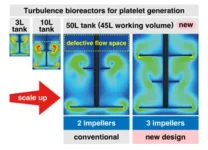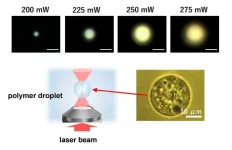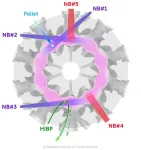Terahertz technology could help us meet the ever-increasing demand for faster data transfer rates. However, the down-conversion of a terahertz signal to arbitrary lower frequencies is difficult. In a recent study, researchers from Japan have developed a new strategy to up- and down-convert a terahertz signal in a waveguide by dynamically modifying its conductivity using light, creating a temporal boundary. Their findings could pave the way to faster and more efficient optoelectronics and enhanced telecommunications.
As we plunge deeper into the Information Age, the demand for faster data transmission keeps soaring, accentuated by fast progress in fields like deep learning and robotics. Against this backdrop, more and more scientists are exploring the potential of using terahertz waves to develop high-speed telecommunication technologies.
However, to use the terahertz band efficiently, we need frequency division multiplexing (FDM) techniques to transmit multiple signals simultaneously. Of course, being able to up-convert or down-convert the frequency of a terahertz signal to another arbitrary frequency is a logical prerequisite to FDM. This has unfortunately proven quite difficult with current technologies. The main issue is that terahertz waves are extremely high-frequency waves from the viewpoint of conventional electronics and very low-energy light in the context of optics, exceeding the capabilities of most devices and configurations across both fields. Therefore, a radically different approach will be needed to overcome current limitations.
Surprisingly, in a recent study published in Nanophotonics on May 20, 2024, a research team including Assistant Professor Keisuke Takano from the Faculty of Science, Shinshu University, Japan, reported an innovative solution for the frequency down-conversion of terahertz waves. Their paper was co-authored by Fumiaki Miyamaru from Shinshu University, Toshihiro Nakanishi from Kyoto University, Yosuke Nakata from Osaka University, and Joel Pérez-Urquizo, Julien Madéo, and Keshav M. Dani from Okinawa Institute of Science and Technology.
The proposed strategy is based on the frequency conversions that occur in time-varying systems. Much like a waveguide confines a traveling wave packet in space, there is an analogous concept that occurs in time known as temporal waveguiding. Simply put, variations that occur across an entire system over time will act as a ‘temporal boundary.’ Similar to spatial boundaries (e.g., the interface between two different mediums), temporal boundaries can alter the dispersion properties of the waveguide, giving rise to different propagation modes at new frequencies.
To create this temporal boundary, the researchers first laid out a GaAs waveguide over a thin metallic layer. As terahertz waves traveled through the waveguide in the transverse magnetic (TM) mode, they shined a light on the bare GaAs surface. The resulting photoexcitation of the top surface instantaneously altered its conductivity, effectively turning the bottom-metalized waveguide into a parallel double-metalized waveguide. This transition from one waveguide structure to another acted as the temporal boundary, at which the incident TM modes of the bare waveguide coupled with the transverse electromagnetic (TEM) mode of the double-metalized waveguide. Given that the dispersion curve of the TEM mode occupies a lower frequency range than that of the incident TM mode, this approach produces a frequency-down-shifted terahertz wave.
The research team ran experiments that ultimately validated their thorough theoretical analysis of the proposed frequency conversion method. Thus, the findings of this study paint a bright future for upcoming terahertz technology. Excited about the results, Dr. Takano says: “Frequency conversion devices for terahertz waves have the potential to be applied to future ultra-high-speed wireless communications. For example, they could enable information replication between terahertz wave frequency channels carrying different data. There may also be devices where terahertz wave information processing circuits are integrated with various optical processing components.” Worth noting, up-conversion through the proposed approach has been also demonstrated in "F. Miyamaru et al., Phys. Rev. Lett., 127, 053902 (2021). DOI: 10.1103/PhysRevLett.127.053902". Moreover, the up- and down-conversion can be switched by manipulating the polarization of the input terahertz waves, which would help make FDM in the terahertz range more convenient.
To top this off, the present frequency conversion method is not strictly limited to terahertz waveguides and could also have important implications in optics. “It is important to recognize that the concept of this study extends beyond the terahertz frequency range and can be applied to the optical frequency range as well. Ultrafast frequency conversion devices comprising optically modulated waveguides with indium tin oxide may also be possible, based on recent findings” remarks Dr. Takano.
Further developments in this field could ultimately lead to faster and more energy-efficient telecommunications, helping us build a more interconnected and sustainable society.
###
About Shinshu University
Shinshu University is a national university founded in 1949 and located nestling under the Japanese Alps in Nagano known for its stunning natural landscapes. Our motto, "Powered by Nature - strengthening our network with society and applying nature to create innovative solutions for a better tomorrow" reflects the mission of fostering promising creative professionals and deepening the collaborative relationship with local communities, which leads to our contribution to regional development by innovation in various fields. We’re working on providing solutions for building a sustainable society through interdisciplinary research fields: material science (carbon, fiber and composites), biomedical science (for intractable diseases and preventive medicine) and mountain science, and aiming to boost research and innovation capability through collaborative projects with distinguished researchers from the world. For more information visit https://www.shinshu-u.ac.jp/english/ or follow us on X (Twitter) @ShinshuUni for our latest news.
END








